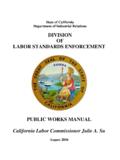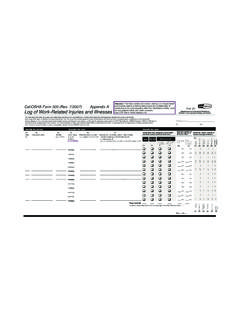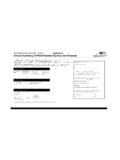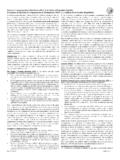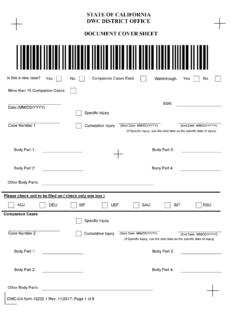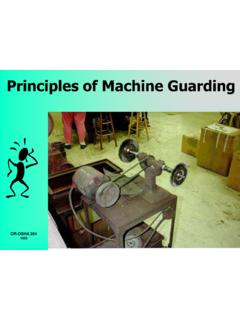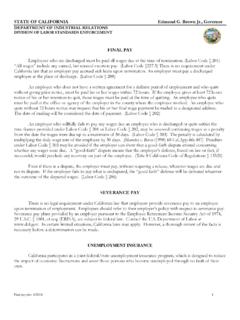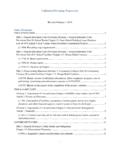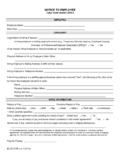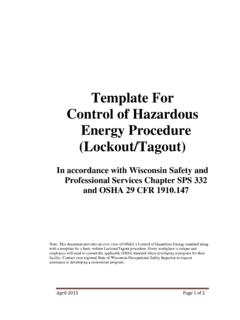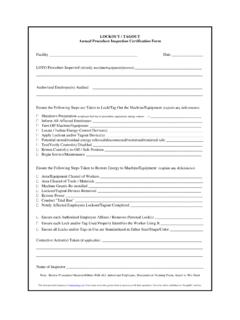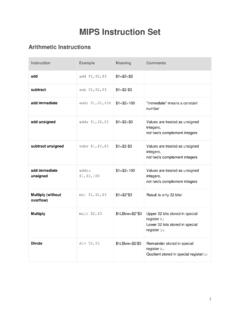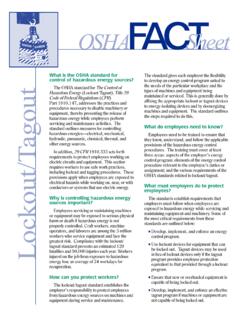Transcription of LOCKOUT / TAGOUT (LOTO) - California Department of ...
1 LOCKOUT / TAGOUT (LOTO) Ruben D. Garza Safety Consultant State of California Department of industrial relations Cal/OSHA Consultation VPP Unit October 2, 2013 Topics of Discussion Definitions LOTO Required LOTO Other Requirements LOTO Materials & Hardware Hazardous Energy Control procedures (HECPS) Periodic Inspections Training Alternative Measures LOCKOUT / TAGOUT Definitions What is LOCKOUT ? LOCKOUT means the use of devices, positive methods and procedures to effectively isolate or secure prime movers (the source of mechanical power), machinery and equipment from hazardous energy sources. LOCKOUT / TAGOUT Definitions Examples of hazardous energy sources include: mechanical, hydraulic, pneumatic, chemical, electrical, thermal, potential and other sources.
2 LOCKOUT / TAGOUT Definitions What Activities are Included in LOCKOUT / TAGOUT ? Cleaning, repairing, servicing, setting-up, adjusting, and unjamming prime movers, machines, and equipment. LOCKOUT / TAGOUT Definitions Which employees are at risk of injury? Employees risk of injury from equipment and machines varies depending on what they are doing. There are two categories of employee: Authorized Affected LOCKOUT / TAGOUT Definitions Authorized Employees or Persons - A qualified person who locks out or tags out specific machines or equipment in order to perform cleaning, repairing, servicing, setting-up, and adjusting operations on that machine or equipment. LOCKOUT / TAGOUT Definitions Qualified Person: A person designated by the employer who by reason of training and experience has demonstrated the ability to safely perform their duties and, where required, is properly licensed in accordance with federal, state or local laws and regulations.
3 LOCKOUT / TAGOUT Definitions Affected Employees - An employee whose job requires them to operate or use a machine or equipment on which cleaning, repairing, servicing, setting-up or adjusting operations are being performed under LOCKOUT or TAGOUT , or whose job requires the employee to work in an area in which such activities are being performed under LOCKOUT or TAGOUT . LOCKOUT / TAGOUT Definitions What is a Prime Mover? The source of mechanical power for a machine. LOTO Required When is LOCKOUT / TAGOUT Required? LOCKOUT / TAGOUT is required when the unexpected energization or start up (or release of stored energy ) of machines, equipment or prime movers could injure workers during cleaning, repairing, servicing, setting-up, adjusting and un-jamming. LOCKOUT Required When is LOCKOUT / TAGOUT Required?
4 During Cleaning, Servicing, Adjusting Operations: Machinery or equipment capable of movement must be stopped and power source(s) de-energized or disengaged. Accident prevention signs or tags or both must be placed on the controls of the power source of the machinery or equipment. Tags must be completed with the following information: Reason for placing tag. Name of person placing the tag and how that person may be contacted. Date tag was placed. LOCKOUT Required When is LOCKOUT / TAGOUT Required? If necessary, the moveable parts must be mechanically blocked or locked out to prevent inadvertent movement, or release of stored energy. A mechanical block to prevent the machine part from falling on employees. LOCKOUT Required Exception If machinery or equipment must move during these operations you must minimize the hazard by providing and requiring the worker to use extension tools (eg.)
5 , extended swabs, brushes, scrapers) or other methods, or means to protect workers from injury. Workers must receive thorough training on the safe use and maintenance of these tools, methods or means. LOCKOUT Required Use of Extension Tools LOTO Required During Repair Work and Setting-Up Operations, Machines, Equipment /Prime Movers: Must be locked out or positively sealed in the "off" position if they have lockable controls (or are readily adaptable to lockable controls). Must be de-energized or disconnected from their power source (or other actions taken to effectively prevent inadvertent movement or release of stored energy) if they do not have lockable controls Accident prevention signs and tags (or both) must be placed on the controls LOTO Required Outside Servicing Personnel Whenever outside servicing personnel are to be engaged in activities covered by the LOCKOUT / TAGOUT regulation, the employer s on-site LOCKOUT or TAGOUT procedures must be followed.
6 LOTO Other Requirements Under certain specific conditions or when working on certain types of machines and equipment, LOCKOUT / TAGOUT is not required. Instead, other requirements apply. During Cleaning, Servicing, Adjusting, Repair Work and Setting-Up Operations If You Are: Making Minor tool Changes and Adjustments, and Other Minor Servicing Activities: That take place during normal production operations and, Are routine, repetitive and integral to the use of equipment or machinery for production and, Using alternative measures to provide effective protection OR Using Cord and Plug Connected Electrical Equipment: Which can be unplugged from the energy source and The plug is under the exclusive control of the employee performing the work. LOTO Other Requirements When Working With Repetitive Process Machines (Robotic) On repetitive process machines, such as numerical control machines, which require power or current continuance to maintain indexing and where repair, adjustment, testing, or setting-up operations cannot be accomplished with the prime mover or hazardous energy source disconnected, such operations may be performed under the following conditions: The operating station where the machine may be activated must at all times be under the control of a qualified operator or craftsman.
7 All participants must be in clear view of the operator or in positive communication with each other. All participants must be beyond the reach of machine elements which may move rapidly and present a hazard to them. Where machine configuration or size requires that the operator leave the control station to install tools, and where machine elements exist which may move rapidly if activated, such elements must be separately locked out by positive means. During repair procedures where mechanical components are being adjusted or replaced, the machine shall be de-energized or disconnected from its power source. LOTO Other Requirements No accidents prevention signs or tags are required if there is a uniform system with unique and personally identifiable locks designed for LOCKOUT , that are placed on the source of energy.
8 LOTO Materials & Hardware Accident prevention signs, tags, padlocks, seals or other similarly effective means which may be required for cleaning, servicing, adjusting, repair work or setting-up operations must be provided. Signs, tags, padlocks, and seals must have means by which they can be readily secured to the controls. TAGOUT device attachment means shall be of a non-reusable type, attachable by hand, self-locking, and non-releasable with a minimum unlocking strength of no less than 50 pounds. Examples of LOCKOUT devices LOCKOUT / TAGOUT devices - storage board Gate valve LOCKOUT device Examples of LOCKOUT devices Locks and tags for electrical panels Examples of LOCKOUT devices Pneumatic energy isolation device Cord and plug LOCKOUT device Examples of LOCKOUT devices LOCKOUT / TAGOUT hardware - lock, tag, and hasp Equipment switch lock and tag Examples of LOCKOUT devices Breaker switch lock and tag Plug lock and tag Examples of LOCKOUT devices Plug LOCKOUT device Gang LOCKOUT device Hazardous Energy Control procedures (HECPS) Each machine, piece of equipment or prime mover must have separate procedural steps for their safe LOCKOUT / TAGOUT .
9 Exception: The same procedural steps may be used for the safe LOCKOUT / TAGOUT of groups or types of prime movers, machines or equipment, under the following conditions: Operational controls are configured in a similar manner, and Locations of disconnect points (energy isolating devices) are identified, and The sequence of steps to safely LOCKOUT or TAGOUT the machinery or equipment are similar. OR Machinery or equipment has a single energy supply that is readily identified and isolated and has no stored or residual hazardous energy. Hazardous Energy Control procedures (HECPS) The HECPS must clearly and specifically outline at least the following: The machines, equipment, operations, and processes where they apply ( , scope) What the procedures are used for ( , purpose and intended use) The name of the people who will carry out the procedures ( , authorization) Rules for carrying out the procedures The means to enforce compliance with the procedures Techniques used for the control of hazardous energy The steps (meaning the procedures and requirements) for: Shutting down, isolating, blocking, and securing machines or equipment to control hazardous energy.
10 The placement, removal, and transfer of LOCKOUT / TAGOUT devices and who is responsible ( , responsibilities) and, Testing to determine and verify the effectiveness of LOCKOUT and TAGOUT devices and other hazardous energy control devices. Hazardous Energy Control procedures (HECPS) Tools To help you determine all the hazardous energy sources for each machine, piece of equipment or prime mover, see tool A; Equipment Audit - Energy Source Determination For Sample LOCKOUT / TAGOUT procedures , see tool B; GENERAL LOCKOUT / TAGOUT PROCEDURE To help ensure that all necessary steps have been taken when performing LOCKOUT / TAGOUT , see tool C; Sample LOCKOUT / TAGOUT Safety Permit Periodic Inspections There must be a periodic inspection of the energy control procedure(s) at least once a year to evaluate their continued effectiveness and determine the necessity for updating the written procedure(s).
